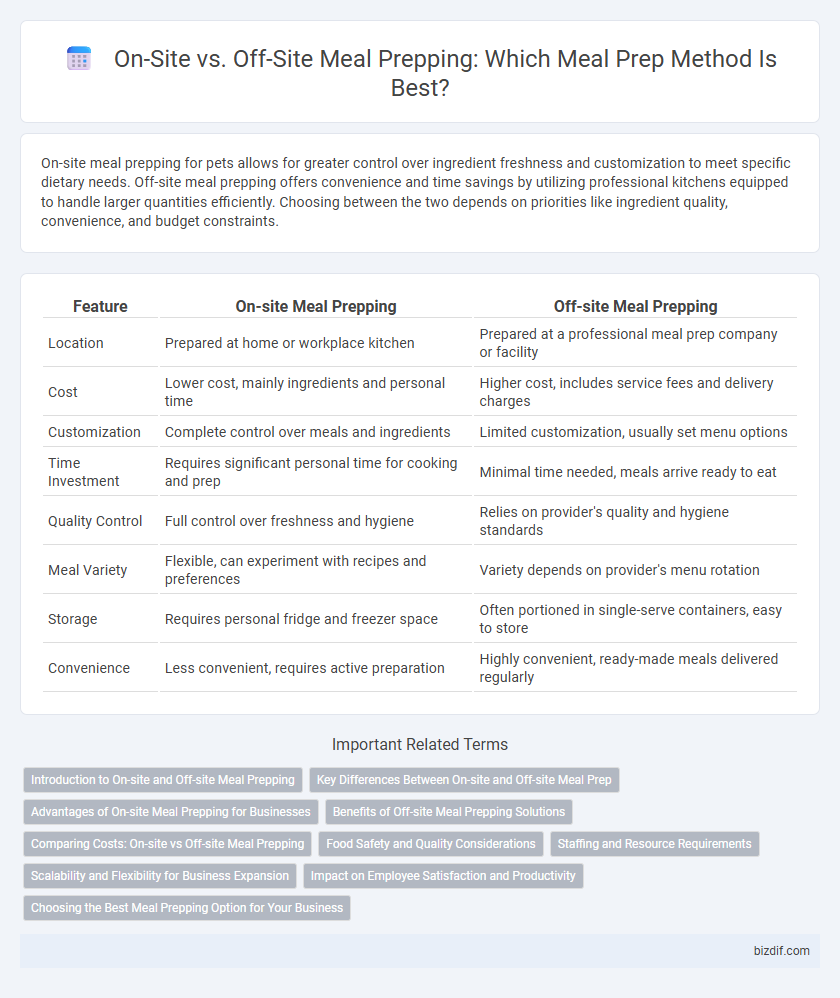On-site meal prepping for pets allows for greater control over ingredient freshness and customization to meet specific dietary needs. Off-site meal prepping offers convenience and time savings by utilizing professional kitchens equipped to handle larger quantities efficiently. Choosing between the two depends on priorities like ingredient quality, convenience, and budget constraints.
Table of Comparison
| Feature | On-site Meal Prepping | Off-site Meal Prepping |
|---|---|---|
| Location | Prepared at home or workplace kitchen | Prepared at a professional meal prep company or facility |
| Cost | Lower cost, mainly ingredients and personal time | Higher cost, includes service fees and delivery charges |
| Customization | Complete control over meals and ingredients | Limited customization, usually set menu options |
| Time Investment | Requires significant personal time for cooking and prep | Minimal time needed, meals arrive ready to eat |
| Quality Control | Full control over freshness and hygiene | Relies on provider's quality and hygiene standards |
| Meal Variety | Flexible, can experiment with recipes and preferences | Variety depends on provider's menu rotation |
| Storage | Requires personal fridge and freezer space | Often portioned in single-serve containers, easy to store |
| Convenience | Less convenient, requires active preparation | Highly convenient, ready-made meals delivered regularly |
Introduction to On-site and Off-site Meal Prepping
On-site meal prepping involves preparing meals directly at the location where they will be consumed, such as a restaurant or workplace kitchen, ensuring freshness and customization. Off-site meal prepping takes place in a separate facility or home kitchen, where meals are prepared in bulk, packaged, and then delivered or stored for later consumption. Both methods offer distinct advantages in terms of convenience, control over ingredients, and time management for busy individuals or businesses.
Key Differences Between On-site and Off-site Meal Prep
On-site meal prepping involves preparing meals directly at the location where they will be consumed, ensuring maximum freshness and customization to dietary needs. Off-site meal prepping occurs at a separate facility, allowing for large-scale production and consistent portion control, often favored by meal delivery services. Key differences center around freshness, customization, cost efficiency, and logistical complexity, with on-site offering tailored, fresher meals and off-site emphasizing standardization and convenience.
Advantages of On-site Meal Prepping for Businesses
On-site meal prepping allows businesses to maintain strict quality control and ensure freshness by preparing meals directly in their facilities. This approach reduces transportation costs and minimizes the risk of food spoilage or contamination during delivery. Furthermore, on-site meal prepping offers customization flexibility to meet specific dietary needs and branding requirements, enhancing customer satisfaction and loyalty.
Benefits of Off-site Meal Prepping Solutions
Off-site meal prepping solutions offer convenience by saving time on grocery shopping and cooking, allowing individuals to focus on other priorities. These services often provide professionally prepared, nutritionally balanced meals tailored to specific dietary needs, ensuring consistent portion control and quality. Outsourcing meal prep reduces kitchen cleanup and minimizes food waste through precise meal planning and packaging.
Comparing Costs: On-site vs Off-site Meal Prepping
On-site meal prepping typically incurs higher costs due to expenses for kitchen equipment, staff salaries, and facility maintenance, while off-site meal prepping often reduces overhead by utilizing centralized commercial kitchens or outsourcing to third-party providers. Off-site meal prepping can leverage economies of scale, making bulk ingredient purchasing and streamlined production more cost-effective compared to smaller scale on-site operations. Businesses and individuals should evaluate initial investments, ongoing operational costs, and potential savings from bulk processing to determine the most cost-efficient meal prepping solution.
Food Safety and Quality Considerations
On-site meal prepping allows for greater control over food safety protocols, including immediate temperature monitoring and minimizing cross-contamination risks, enhancing overall food quality. Off-site meal prepping requires stringent packaging and transportation standards to maintain food integrity and prevent spoilage during delivery. Both methods demand adherence to hazard analysis critical control point (HACCP) guidelines to ensure consistent safety and freshness.
Staffing and Resource Requirements
On-site meal prepping demands a dedicated kitchen staff, including chefs, kitchen assistants, and cleaning personnel, along with ample kitchen space and equipment to handle preparation and cooking simultaneously. Off-site meal prepping consolidates resources in a centralized facility, optimizing staff efficiency by specializing roles and utilizing industrial-grade equipment, which reduces labor costs and space needs at the serving location. Staffing requirements for off-site meal prepping typically involve logistics and quality control teams to ensure timely delivery and meal freshness, contrasting with the continuous hands-on staff presence required on-site.
Scalability and Flexibility for Business Expansion
On-site meal prepping offers greater control over food quality and customization, enabling businesses to quickly adapt recipes and portion sizes to meet customer demands, enhancing flexibility for growth. Off-site meal prepping leverages centralized production facilities to efficiently scale operations and reduce overhead costs, supporting rapid expansion across multiple locations. Balancing on-site customization with off-site scalability allows meal prep companies to optimize resources while addressing diverse market needs.
Impact on Employee Satisfaction and Productivity
On-site meal prepping allows employees to enjoy freshly prepared meals, fostering a sense of community and reducing time spent away from work, which enhances overall productivity. Off-site meal prepping, while convenient, can lead to longer breaks and less control over meal quality, potentially diminishing employee satisfaction. Companies investing in on-site meal services often see higher employee engagement and improved workplace morale.
Choosing the Best Meal Prepping Option for Your Business
On-site meal prepping allows businesses to maintain strict quality control and customize meals to meet specific dietary preferences, enhancing customer satisfaction through fresh preparation. Off-site meal prepping offers greater efficiency and cost savings by leveraging specialized facilities with streamlined production processes, ideal for scaling operations and reducing overhead. Evaluating factors such as budget, volume requirements, and control over ingredient sourcing is crucial when deciding the most suitable meal prepping approach for your business.
On-site meal prepping vs off-site meal prepping Infographic

 bizdif.com
bizdif.com